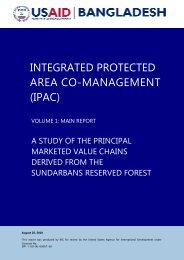Child Equity Atlas - BIDS
Child Equity Atlas - BIDS
Child Equity Atlas - BIDS
You also want an ePaper? Increase the reach of your titles
YUMPU automatically turns print PDFs into web optimized ePapers that Google loves.
<strong>Child</strong> <strong>Equity</strong> <strong>Atlas</strong><br />
2011-2015 prioritizes programmes to reach the<br />
47 million people living below the poverty line.<br />
A significant proportion of the poor are living in<br />
households which are female headed, in remote<br />
areas, and consisting of socially excluded and<br />
other vulnerable people. Their access to secondary<br />
and tertiary education is limited and the quality of<br />
education at all levels is deficient. The Government<br />
recognized that a large segment of the population<br />
is severely disadvantaged in terms of ownership of<br />
assets and has inadequate access to institutional<br />
finance as well as to basic services including quality<br />
education, healthcare, water and sanitation. These<br />
people, and among them especially women and<br />
children, are also disproportionately affected<br />
by natural disasters and the adverse effects of<br />
climate change. Despite expansion, publicly<br />
supported mitigating measures in the form of<br />
social protection programmes are numerous but<br />
still inadequate and insufficiently child sensitive or<br />
equity focused.<br />
1.0.7 To make evidence based policy and budget<br />
decisions, the general public and policy makers<br />
need to visualize social deprivation issues at<br />
administrative levels to show the persisting<br />
inequalities and pockets of entrenched social<br />
deprivations. For Bangladesh’s growth and<br />
development to be socially inclusive, equity issues<br />
need to be unpacked at geographic levels that<br />
engender mutual accountability for all stakeholders<br />
– civil society, local leaders, private sector<br />
practitioners, and Government and development<br />
partners. The understanding of existing social<br />
inequalities will gauge the success of existing<br />
policies and serve as a basis for subsequent policy<br />
reform, and investment decisions.<br />
1.0.8 The Government of Bangladesh and its<br />
partners invested a lot of resources to complete<br />
the Population and Housing Census 2011<br />
(commonly known as Population Census 2011)<br />
and validated the Census results. The Census<br />
data is a vital source for development planning<br />
and policy. The availability of the 2011 Census<br />
data, to the individual and household levels,<br />
offers scope for a low cost approach to equity<br />
based policy analysis and advocacy for reducing<br />
inequality.<br />
1.0.9 Hence this study – in a tripartite partnership<br />
between the Bangladesh Bureau of Statistics<br />
(BBS), Bangladesh Institute of Development<br />
Studies (<strong>BIDS</strong>), and UNICEF – analysed the 2011<br />
census data, with the following objectives.<br />
1.1 Objectives and Scope<br />
1.1.1 The overall objective of the study is to<br />
analyse the 2011 Census data to understand<br />
the patterns of social inequalities, identify areas<br />
of progress and persisting pockets of social<br />
deprivation; and engender evidence based<br />
dialogue and informed decisions to increase<br />
the equity focus of social development policies<br />
and programmes for equitable realization of the<br />
socioeconomic rights of children and women in<br />
Bangladesh.<br />
1.1.2 Specific objectives of the study include the<br />
following:<br />
1. Harness the detailed information available<br />
in the census, done once in 10 years, to<br />
have reliable data at levels below districts<br />
at virtually no additional cost.<br />
2. Make the census data more accessible,<br />
user friendly so as to unearth child<br />
centered inequities such as girls married<br />
between 15 to 19 years, “real child worker”,<br />
etc. in graphs and maps.<br />
4














